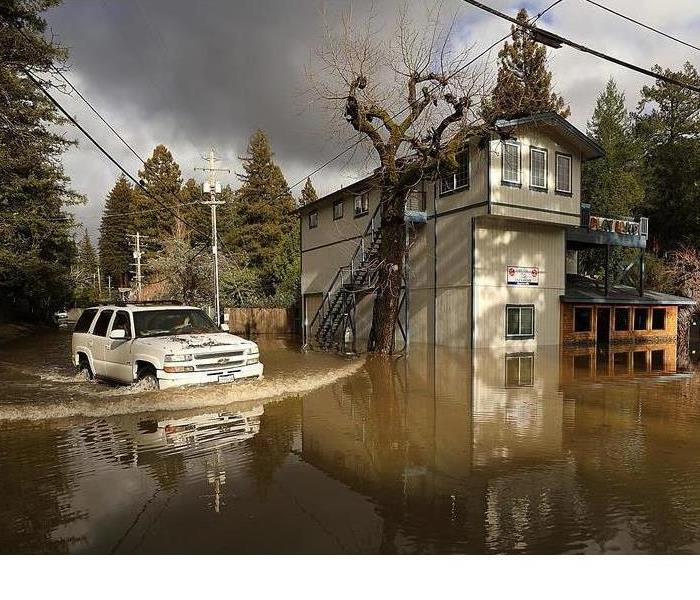Protect Your Bay Area Home from Rainstorm Flooding
2/20/2019 (Permalink)
The entire state of California, including Northern California and the Bay Area, is experiencing historic rainfall this winter.
As you already know, if you’re a homeowner in Palo Alto, Atherton, Stanford, Menlo Park, or Redwood City, you have the responsibility to protect your home from both natural disasters like our current rainstorms in addition to made-made water damage issues. While you can’t predict natural disasters like flooding, you can help protect your home from water damage due to severe rains and floods. According to FEMA, the Federal Emergency Management Agency, floods are the most common and most expensive natural disaster in the U.S., and no state is immune to the effects of flash flooding. Flash flooding happens everywhere, causing water damage requiring water restoration and mold mitigation services (because water leads to mold damage) including in places like Palo Alto, Menlo Park, Atherton, and Redwood City, California.
Heavy rains have hit Santa Clara County, California hard this winter. Here are a few tips from the Insurance Institute for Business & Home Safety, or IBHS, that you, as a Bay Area homeowner, can help use to protect your home from flooding to help minimize water damage that can cause ruined carpets, wrecked appliances, and irreversibly damaged family heirlooms and keepsakes. Just one inch of water can cause significant damage. One inch!
Before taking any of the steps below, you need to first find out your home’s flood level, which is an official measure of how high floodwaters could rise where you live. You’ll find this information by checking the online flood maps on FEMA’s website or by asking your home insurance agent.
Safeguard in-home electrical and climate systems
It’s important to safeguard your electrical and climate systems. Make sure to raise switches, sockets, circuit breakers, and wiring at least a foot above the expected flood level in your area. And don’t forget to modify your furnace and water heater so they sit above your property’s flood level instead of at or below it.
Anchor and raise outdoor power equipment
Again, you have to think of your property’s flood level. Fuel tanks, air-conditioning units, and power generators should be anchored and raised above your flood level. If not, unanchored fuel tanks can break free, and severed supply lines will contaminate surrounding ground, creating an even larger problem. Any electrical power units and generators should never sit on the ground. Water will render them useless.
Modify water valves
A flooded sewer system can cause sewage to back up into your home, which is both distressing and dangerous to your family’s health. Install an interior or exterior backflow valve to prevent the sewage from spreading all over your house. The Federal Alliance for Safe Homes, or FLASH, recommends gate valves that you have to operate by hand. Their benefit is that they provide stronger seals than flap or check valves, which open automatically to allow water to flow out and then close when water tries to get in.Install these valves on all pipes entering the house, advises FLASH.
Figure out how water flows around your house
The angle of the ground (called slope or grading) can direct water to or away from your house. Obviously, it’s best if the home was built so that water drains away from the building, but that’s not the case for all homes, particularly older ones. Just check it out during a regular rainstorm to see how the water flows around your house.
- Take on-the spot actions as soon as you anticipate flooding during a rainstorm
- Clear gutters, drains and downspouts (This should be done regularly at least twice a year.)
- Move furniture, rugs, electronics and other belongings to upper floors, or at least raise them off a ground floor or out of a basement, if you have one.
- Shut off electricity at the breaker panel, and make sure everyone in the house knows how to do this!
- Elevate major appliances onto concrete blocks if they’re potentially in harm’s way from flooding. You don’t want to have to repair or replace expensive appliances every time there’s a major rainstorm.
What happens if you take most of these actions during heavy rains and still have water damage? Don't fret. First call a reputable damage restoration company like SERVPRO of Palo Alto. SERVPRO of Palo Alto’s expertly trained restoration technicians are trained to take care of water damage and mold mitigation due to flash flooding and heavy rains. They serve the following areas of Santa Clara County: Palo Alto, Menlo Park, Atherton, and Redwood City, and have taken on water damage jobs both large and small. In addition, their customers give SERVPRO of Palo Alto excellent reviews for their quick, efficient, and high-quality water restoration work and mold mitigation work. Call us today for a quick, no-cost estimate at (650) 800-3448!



 24/7 Emergency Service
24/7 Emergency Service
